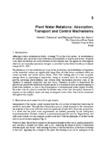Please use this identifier to cite or link to this item:
http://www.alice.cnptia.embrapa.br/alice/handle/doc/925116| Title: | Plant water relations: absorption, transport and control mechanisms. |
| Authors: | CHAVARRIA, G.  SANTOS, H. P. dos   |
| Affiliation: | GERALDO CHAVARRIA, UPF; HENRIQUE PESSOA DOS SANTOS, CNPUV. |
| Date Issued: | 2012 |
| Citation: | In: MONTANARO, G.; DICHIO, B. (Ed.). Advances in selected plant physiology aspects. Rijeka: In Tech, 2012. |
| Pages: | p. 105-132. |
| Description: | Although water is abundant on Earth - covering 71% of the total surface - its distribution is not uniform and can easily cause restrictions in availability to vegetal production. At global scale, these restrictions are easily observed in dry climates and can appear in other regions which do not currently experience drought, as provided by the future backdrop of climate change (IPCC, 2007). The influences of water restriction on losses in the production and distribution of vegetation on the terrestrial surface are significantly larger than all other losses combined which are caused by biotic and abiotic factors (Boyer, 1985). This striking effect of water on plants emerges from its physiological importance, being an essential factor for successful plant growth, involving photosynthesis and several other biochemical processes such as the synthesis of energetic composites and new tissue. Therefore, in order to characterise the growth and productive behaviour of plant species it is essential to have an understanding of plant water relations, as well as the consequences of an inadequate water supply. Broadly, the water state of a plant is controlled by relative rates of loss and absorption, moreover it depends on the ability to adjust and keep an adequate water status. This will be considered throughout this chapter. |
| Thesagro: | Fisiologia vegetal Água Planta |
| ISSN: | 978-953-51-0557-2 |
| Type of Material: | Parte de livro |
| Access: | openAccess |
| Appears in Collections: | Capítulo em livro científico (CNPUV)  |
Files in This Item:
| File | Description | Size | Format | |
|---|---|---|---|---|
| InTechPlantwaterrelationsabsorptiontransportandcontrolmechanisms.pdf | 1,77 MB | Adobe PDF |  View/Open |









